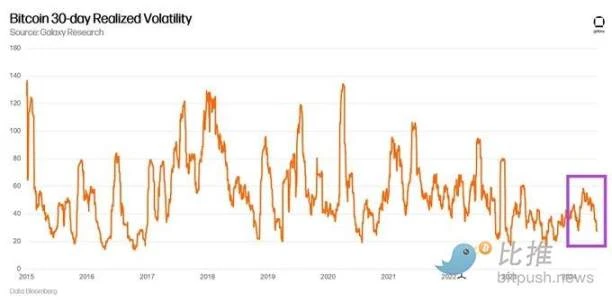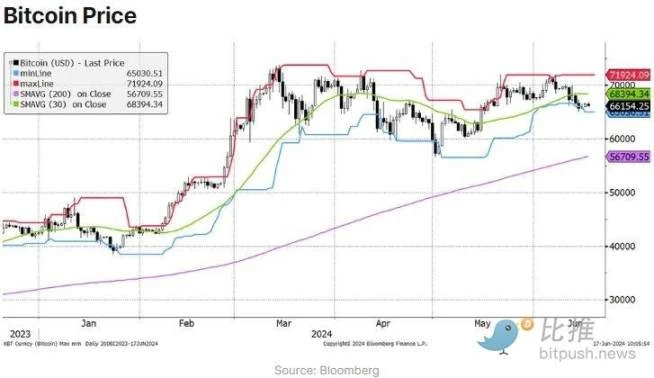Has the summer slump begun? Crypto funds have seen the largest weekly outflows since late March
Original author: Mary Liu, BitpushNews
Crypto markets faced downward pressure at the open on Monday.
According to Bitpush data, Bitcoin fell below the $66,000 support level in early trading and hit a low of $65,046 in midday trading. A surge in buying then pushed the price back to $67,286. However, the bullish momentum failed to continue. As of press time, the price of Bitcoin was $66,580.16, with a 24-hour volatility close to 0%.
Only five of the top 200 tokens by market value rose by more than 1% on Monday, with Convex Finance (CVX) leading the way with a 25.3% increase, followed by cat in a dogs world (MEW), which rose by 19.7%, and XRP, which rose by 5.8%. zkSync (ZK) fell the most, down 24.3%, io.net (IO) fell 22.1%, and ConstitutionDAO (PEOPLE) fell 18.7%.
The current overall market value of cryptocurrencies is $2.41 trillion, and Bitcoin’s market share is 54.6%.
In the traditional market, AI-related stocks remained popular, with the SP 500 and the tech-heavy Nasdaq 100 continuing to climb to record highs, up 0.9% and 1.2% respectively.
Some analysts adjusted their target values for the SP 500 this year, with Evercore ISI raising its year-end target price to 6,000 and Goldman Sachs predicting the index will reach 5,600.
Will the first rate cut be in September or at the end of the year?
Investors currently see a 64% chance of a rate cut in September, according to the CME Groups FedWatch tool.
However, Minneapolis Fed President Neel Kashkari said in an interview with CBS on Sunday that it was a reasonable forecast that the central bank would probably cut interest rates once this year and wait until December.
BitPush previously reported that the Federal Reserve kept its benchmark interest rate in the range of 5.25%-5.50% last week, marking that the interest rate has remained at this level for nearly a year.
The year-over-year change in the Federal Reserves preferred inflation measure, the personal consumption expenditures price index, was 2.7% in April, well above the Feds 2% target.
“We need to see more evidence that inflation is moving back down to 2%,” Kashkari said. “Right now we are in a very good position to slowly get more inflation data, more economic data, more labor market data before we make any decisions. We are in a good position, but if you were just saying there would be one rate cut, as the median suggests, it would probably be before the end of the year.”
The summer slump has begun
Bitcoin has been trading sideways in a narrow range since March. Alex Thorn, head of research at digital asset investment firm Galaxy, noted in an X post that Bitcoin’s 30-day realized volatility has fallen to near all-time lows, highlighting the boring price action.
In addition, CoinShares June 17 report showed that digital asset exchange-traded products and funds saw outflows of $600 million last week, the largest outflow since March 22, and the total assets under management of crypto funds fell from $100 billion to $94 billion.
Data from CoinShares showed that global digital asset investment product trading volume last week was also lower than the weekly average of $22 billion this year, at $11 billion. The trading volume of the U.S. spot Bitcoin ETF was $8.73 billion, but it was still far below the peak of $32.69 billion in the week of March 4-8.
Derivatives trading network Paradigm says the cryptocurrency market is “losing steam” due to a lack of catalysts for traders to take action. “Despite all the positive predictions, new markets need real news to drive and maintain traction,” the company said in a Telegram update earlier today.
Analysts at Secure Digital Markets believe that “investors are ‘flying to quality’ after the Fed’s hawkish stance. During periods of market uncertainty, investors move capital from riskier investments to safer assets to minimize losses and preserve capital.”
Charlie Morris, chief analyst at ByteTree, said on-chain data suggests Bitcoin’s weakness will continue for at least a few months as “the value of transactions in USD has fallen.”
Morris wrote: I dont know how long this will last, but it seems like a decisive change. It suggests we shouldnt be surprised by a breakout to the downside. The predictions that the halving will bring Bitcoin to new highs have been dashed. Despite strong ETF inflows this year, the price has repeatedly hit resistance above $70,000. Today, the price fell back below the 30-day moving average and the trend has fallen 2/5. However, it remains in a long-term uptrend.
Morris said: My thesis has not changed, which is that Bitcoin will break out in October after a summer break. This happened in 2016 and 2020. After the halving, the Bitcoin network took a six-month break to stabilize from the pre-halving hype.
According to market analyst TedTalksMacro, this week is crucial for Bitcoin. He analyzed on the X platform: For the next week, it is crucial for Bitcoin to maintain the $66,000 support level. Once it falls below, sellers may dominate the market and force longs to liquidate quickly.
This article is sourced from the internet: Has the summer slump begun? Crypto funds have seen the largest weekly outflows since late March
Related: Systematic understanding of EigenLayer: What are the principles of LST, LRT and Restaking?
Introduction: Restaking and Layer 2 are important narratives of the Ethereum ecosystem in this cycle. Both aim to solve existing problems of Ethereum, but the specific paths are different. Compared with ZK, fraud proof and other technical means with extremely complex underlying details, Restaking is more about empowering downstream projects in terms of economic security. It seems to just ask people to pledge assets and get rewards, but its principle is by no means as simple as imagined. It can be said that Restaking is like a double-edged sword. While empowering the Ethereum ecosystem, it also brings huge hidden dangers. Currently, people have different opinions on Restaking. Some say that it has brought innovation and liquidity to Ethereum, while others say that it is too utilitarian and is accelerating the…










